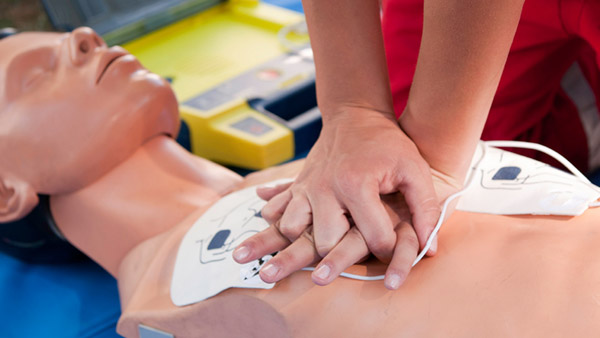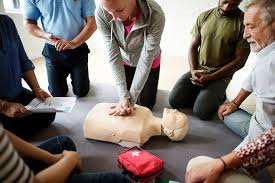Introduction
Cardiopulmonary Resuscitation (CPR) is more than just a collection of upper body compressions and breaths; it's a life-saving skill that can be the difference in between life and death in emergency circumstances. The knowledge acquired from a first help course or CPR course can equip people to respond properly when faced with a heart attack, choking incident, or various other important emergency situations. This post explores the real-life applications of CPR, highlighting its significance and the effect of training on conserving lives.

Real-Life Applications of CPR: When Educating Saves Lives
Understanding CPR
CPR is an important emergency situation treatment made use of to preserve brain function up until more steps are taken to restore spontaneous blood flow and breathing. It entails 2 parts:
Chest Compressions: These resemble the heart's pumping activity to maintain blood flow. Rescue Breaths: These offer oxygen to the lungs, vital for survival.The performance of CPR dramatically enhances when done instantly after heart attack. Researches show that immediate CPR can increase or triple the possibilities of survival for victims.
Importance of Emergency treatment Courses
First help programs gear up individuals with essential abilities past mouth-to-mouth resuscitation, including wound treatment, identifying strokes, and managing cracks. By participating in these courses, you're not simply finding out about emergency situations; you're preparing yourself to act decisively when it matters most.
Key Components of Emergency treatment Courses
- Basic Life Assistance (BLS): Covers grown-up, youngster, and baby mouth-to-mouth resuscitation techniques. Choking Alleviation Techniques: Consists of back impacts and stomach thrusts. Wound Monitoring: Just how to clean up and dress wounds properly. Recognizing Emergencies: Comprehending when to call for aid versus taking care of a scenario independently.
The Function of CPR in Heart Attack Situations
Every year, hundreds of thousands experience cardiac arrest outside healthcare facilities. Without instant intervention, the survival price drops drastically every min that passes without CPR.

Statistics on Heart attack Survival Rates
|Time Without mouth-to-mouth resuscitation|Survival Price (%)|| ------------------|-------------------|| 1 Min|90|| 5 Minutes|50|| 10 Minutes|10|
Source: American Heart Association
Being trained in CPR ensures that spectators can step in confidently throughout these essential moments.
Real-Life Case Studies Showing Effective Mouth-to-mouth Resuscitation Application
Case Study 1: The Quick-Thinking Bystander
In a bustling café one warm afternoon, an individual fell down as a result of cardiac arrest. A close-by restaurant who had completed a first aid and mouth-to-mouth resuscitation course delved into action. They started carrying out upper body compressions while one more patron called 911. Within minutes, paramedics got here and used an Automated External Defibrillator (AED), ultimately revitalizing the patient.
Case Research 2: Office Emergency
During a company training event, a staff member instantly dropped unconscious. The good news is, numerous coworkers were licensed in both emergency treatment programs and sophisticated life assistance techniques. Their quick response included calling emergency services while executing top quality CPR up until help arrived.
Why Take part in mouth-to-mouth resuscitation Courses?
CPR courses deal hands-on training that builds self-confidence in your capacities during emergency situations. Right here are some compelling factors to enroll:
Life-Saving Abilities: You find out exactly how to conserve lives. Boost Confidence: Practical exercises aid cement your skills. Certification Opportunities: Lots of training courses supply certificates upon completion. Community Effect: Educated people add favorably to culture by being ready for emergencies.What Are the Various Kinds Of Mouth-to-mouth Resuscitation Courses Available?
When taking into consideration which training program matches your demands best, it is necessary to comprehend the numerous kinds of available courses:

Basic Adult/Child/Infant mouth-to-mouth resuscitation Course
This course concentrates on age-specific methods customized for grownups, children, and infants with thorough hands-on method on mannequins.
Advanced Cardiovascular Life Assistance (ACLS)
Geared toward medical care specialists, ACLS builds on standard life support abilities with advanced interventions like drug management and advanced air passage management.
Pediatric Advanced Life Assistance (BUDDIES)
Designed for doctor who handle critically unwell infants and kids; PALS includes situations details to pediatric emergencies.
Online vs In-Person Training
Many companies currently provide online modules which can supplement typical class learning however do not change hands-on practice essential for grasping skills like breast compressions.
Benefits of Having an Emergency Treatment Certificate
Obtaining an emergency treatment certification shows your dedication to safety and security and preparedness in numerous environments-- whether at home or work-- enhancing both specialist credibility and personal guarantee when emergency situations arise.
Career Advantages
Having qualification can boost employability in fields such as education and learning, health care industries, physical fitness training markets where safety is paramount.
Common False impressions Concerning CPR
It's important to dispel myths bordering this vital skill set:
Myth # 1: "Just Clinical Professionals Needs To Do mouth-to-mouth resuscitation"
Fact: Any person can execute basic life-saving strategies if trained correctly; you do not need medical expertise!
Myth # 2: "You Can Damage Somebody by Carrying out mouth-to-mouth resuscitation"
While it's true there's some danger included-- it's far exceeded by the potential advantages when carried out correctly!
Myth # 3: "CPR Is Just Necessary For Adults"
Children additionally need timely treatments; hence understanding CPR Course Canberra pediatric approaches is similarly vital!
FAQs Regarding Real-Life Applications of CPR
FAQ 1: What should I do if I see a person collapse?
If you witness someone collapse:
- Check responsiveness Call emergency situation services Begin doing mouth-to-mouth resuscitation quickly if they reveal no indicators of breathing
FAQ 2: Just how typically ought to I restore my certification?
Most companies recommend restoring your emergency treatment certification every two years as a result of evolving guidelines and practices.
FAQ 3: Can I find out mouth-to-mouth resuscitation online?
While online courses give important info, hands-on technique is essential for mastering skills successfully-- seek hybrid choices if possible!
FAQ 4: What are some tips for performing efficient upper body compressions?
Aim for:
- A depth of at least two inches A rate around 100-120 compressions per minute Allow full recoil between compressions without raising hands off the chest
FAQ 5: Do I require special equipment for carrying out rescue breaths?
No unique devices is required! However utilizing barrier gadgets like face shields can boost safety while providing rescue breaths if available.
FAQ 6: What function does AED play along with CPR?
Automated Exterior Defibrillators assess heart rhythm & & encourage whether shocks are needed which considerably increases possibilities of survival when used along with premium chest compressions!
Conclusion
The real-life applications of mouth-to-mouth resuscitation are undeniable; they extend far past academic expertise into actual scenarios where lives are conserved via definitive actions taken by experienced people. Enlisting in a comprehensive first help course or going to specialized CPR courses furnishes you with very useful skills that can make all the distinction during an emergency circumstance-- not just profiting others but equipping on your own too! The time spent today prepares you for whatever tomorrow might bring-- and isn't that something worth considering?